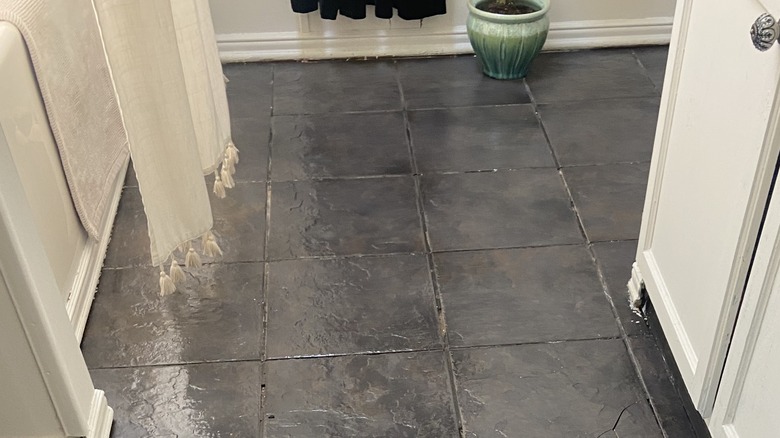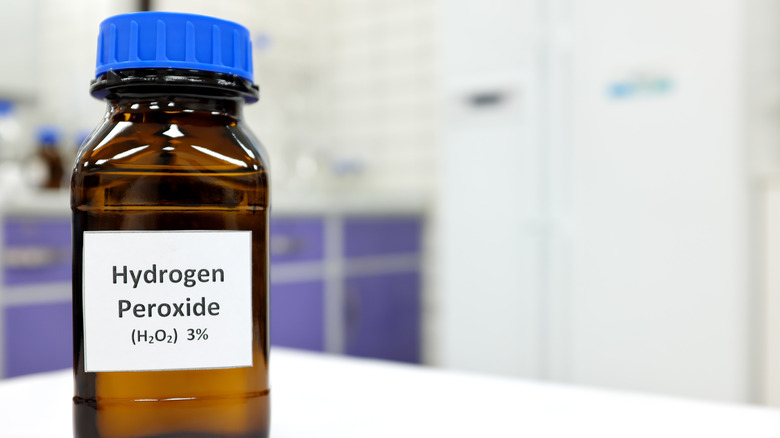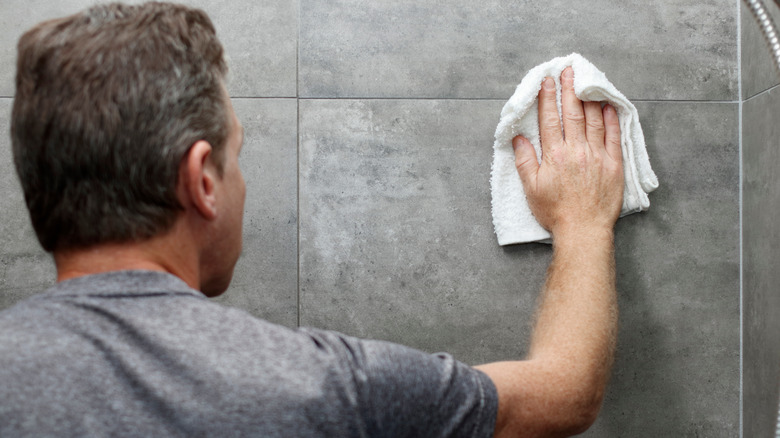The Secret Ingredient You Should Be Using To Clean Slate Tiles
Slate has been used as a building material for millennia. Outdoors, slate shingles seal roofs, keeping the rain and wind out. Indoors, you'll find slate tiles on the floor, in kitchen backsplashes, and lining everything from fireplaces to shower stalls. Of course, like most kinds of natural stone, it's a pricey building material to buy and install. To get the greatest longevity out of your likely impressive investment, you need to keep the tiles clean. You probably already know that cleaning grout with hydrogen peroxide (H2O2) works well, but perhaps you haven't thought to use the stain-busting chemical on the tiles themselves. Well, we're here to tell you that H2O2 will get your slate tiles looking freshly quarried once again.
So, why does H2O2 work so well as a slate cleaner? Slate tiles resist most liquid stains, but spilled substances can still mar them. Like other types of natural stone — think marble and granite — slate is a little bit porous. If red wine, coffee, or ketchup is left on the surface for too long, it could soak into the tile, discoloring it. Hydrogen peroxide works best on slate tiles with non-oil-based, organic, or biological stains (like stains caused by red wine, coffee, tea, fruit, tobacco, paper, food, urine, algae, mildew, and mold). Plus, you'll need to wash your tiles before spot-cleaning with H2O2. This will, incidentally, lift embedded grime, dirt, and dust from the minute cracks and crevices in the natural stone, refreshing the tiles' overall appearance.
Go on a supply run
The first step in knowing how to clean and care for slate flooring or other slate-tiled surfaces is having the right supplies and tools. For cleaning, look for a 3% or 12% (for extra stubborn stains) hydrogen peroxide concentration. Pick up Equate 3% hydrogen peroxide, packaged in a handy 8-fluid-ounce spray bottle, for $1.42 at Walmart. Home Depot has a 12% hydrogen peroxide all-purpose cleaner priced at $21.98 for a 128-ounce bottle. You'll also need a dust and wet mop and some floor cleaner, an old plastic container or jug to dilute your peroxide in, access to clean water, a scrubbing brush (we like this Libman tile brush for $3.99 at Menards), and a few cleaning cloths or kitchen paper. Baking soda is optional if you need to treat stubborn stains. If you think you might want to make a poultice (again, for removing extra bothersome stains), grab a roll of plastic cling film and some masking tape, too.
With your supplies and tools collected, it's time to brush up on some hydrogen peroxide safety. Hydrogen peroxide releases health-harming volatile organic compounds (VOCs) into the air, so always wear a mask when cleaning with it. Plus, since it's mild bleach that can cause skin irritation, it's advisable to don a pair of gloves, some eye protection, pants, and a long-sleeved shirt before you start mixing or scrubbing anything. Oh, and never combine bleach and H2O2; it creates a highly toxic gas.
Stain treatment how-to
If your grout is any other color than white or cream, you may want to rethink your stain-removal strategy. Splashes of hydrogen peroxide will bleach the dyes in colored grout, leaving it looking patchy. Now, it's time to prepare your tiles for spot cleaning. Give them a once-over with a duster (or dust mop if you're cleaning slate flooring), then clean them with a cleaning cloth soaked in soapy water. Again, this would mean wet-mopping the floor as you regularly would, using your standard floor cleaning solution and implements. Let the tiles air dry.
Mix a 1:1 ratio of hydrogen peroxide and water in a spray bottle or jug. Spray or pour the solution onto the stain, scrub the spot with your tile brush, and let it sit for 10 to 30 minutes. Alternatively, soak a paper towel in the watered-down H2O2 and lay it over the stain. If the stain hasn't shifted, splash hydrogen peroxide into baking soda until a thick paste forms. It will bubble. Wait for the reaction to stop before spreading the paste over the stain, leaving it there for two minutes to two hours. Use your cleaning cloth or a paper towel to gently wipe the paste away.
Is the stain still there? A poultice is your last resort. Apply the paste as directed, but this time, cover the patch with cling wrap fastened on all sides with masking tape. Leave the poultice on the tile overnight. Repeat as needed.



